mbya GARABI DAM: sin between two chairs? DESIRE-poem 
DILM ATTACKS, CRISTINA BITING THE APPLE
--- The viable terms of trade that allowed by Brazil Mercosur and Argentina, two disparate regional economies, (one among the eight best in the world, the other growing NEWBORN) seems to be smiling about a great encounter not only gender: Dilma and Cristina but alone, they embrace next January 31 , as before Lula Nestor. Some cardinal sin, as we know, we are united.
Folder to signing agreements is sound: digital TV, roads and investment in mining and third (underlined) the dam SUSPENDED Garabi between Rio Grande Do Sud and Garruchos-Panambi. Although not yet studied areas affected, the urgency is that St. Paul with his twenty million people suffer power cuts.
cheap energy is announced: savings Of course it could be worse than an oil spill will affect nearly 100 km of river cause, beyond San Javier, Misiones. The Uruguay River, that of rafts without fuel, pure water rowing, the sliding of its forest green will be the big hurt surubies.
This monster water stress was put on hold after the loss to Argentina meant the Binational Entity Yaciretá , corruption and debt, but above all the social disaster on the Parana River that now carries a large artificial lake. This risk
know very well the missionaries who lost not only its climate, natural water resources, but part of a territory. Little of Paraná is "sustainable" for orilleros. The microclimate change to the point of marginalization of its inhabitants. Thus, the word "relocated" means new excluded: migrants from poor neighborhoods new Yaciretá flooded land near Posadas.
correntinos They know also that always expect the government to proceed with justice, although they seem suspicious. They dream of a foreign investment to enable them to better living, or sleeping, plus so many real tempted. (3)
In Misiones, would be a "referendum" election, after protests and petitions as "NOT A GARABI! "poster that reads in the whole province with some agony. The red land Garabi know that will change the cause of the Alto Rio Uruguay, not only with its rolling coastal hills that tourists consume as Moconá jumps, but the actual weather that causes tornadoes like Tobuna, never happened before. Little
tell the true agreement between the two presidents. Do you expect the apple to rot?
Even before this demand for energy, Dilma facing the thousand dead in Rio by climate change, and also met with petitions as "MONTE BELO PARE: NÃO À USINA MEGA NA AMAZON" (1) to avoid building a similar Zanjon the Panama Canal on Amazon that touches the lung and leave global climate thousands Aboriginal without their habitat, that is lifeless. Cristina in our Arab countries agree on oil. Environmental organizations prepare an appeal to forestry advice of an engineer, just beginning the struggle (2)
Under the crutch of "sustainable economy" is sailing the master signifier that organizes the field of meanings, ie the value of social exchanges in the neoliberal era, but in the meantime made nature ignites culture (**).
Is there life in the river after Garabi? It's not too late to attend, without nostalgia but with struggles, the ultimate meaning of "Uruguay", poem by The Mensú Ruben Ayala: "... and there in San Javier volver a vivir ".-
ENRIQUE ACUNA.
19 enero 2011 .-
(1 )-Belo Monte would be bigger than the Panama Canal, flooding at least 400,000 hectares of forest by expelling 40,000 indigenous and local populations and destroying valuable habitat for many species - all to create energy that could be easily generated with greater investments in energy efficiency.
The pressure on President Dilma is increasing: the President of IBAMA ended resigning, refusing to issue the environmental permit for Belo Monte and exposing the political pressure to bring this project devastating ahead. Experts, indigenous leaders and civil society agree that Belo Monte is an environmental disaster in the heart of the Amazon.
The works will start soon. We will increase the pressure to stop Dilma Belo Monte! Sign the petition before the bulldozers get to work - it will be delivered in Brasilia.
http://www.avaaz.org/
(2)-http: / / www.primeraedicionweb.com.ar/nota/digital/29082/garabi-analizan-amparo-por-avances-de-proyecto . html
(3) - Es el cuasi whimsy optimism un medio correntino frente al "interés" del vecino giant "It raised the need for further energy integration of the two countries and advance the construction of the dam Garabí, which will generate about 2,900 megawatts, on the Uruguay River, between the provinces of Corrientes and the State of Rio Grande do Sul Garabí The original, dating from the 80 provided for a plant with a capacity to generate 1,800 megawatts but was extended in the interests of Brazil. "
(*) see blog GARABI YES OR NO.
http://represagarabisiono.blogspot.com/2009/11/integrantes-de-abaru-y-asociaciones-de.html
(**)- A position against which analyzes the economic criteria, exploitation and conservation, and the political decision to natural resources is in the article by F. Quetglas posted on this blog:
http://la-chicharraviajera.blogspot.com/2007/06/recursos-y-razones.html
Mr. Eric
Statements Alfredo Barney Abrazián (AA): We will meet 37 years from the commencement of works Yacyretá. Will end with the visit of the President. In parallel we are talking about the start of two monstrous works, not as large as Yacyretá but q can be placed in one sector or another, those who want to build and those who do not want: Garabí and Corpus.
Alejandro Barrionuevo (AB): Over the next few days, the mayors of the south end of missions and the far north of Corrientes will travel to Buenos Ayres to meet Cristina Kirchner, maybe not going to be really promoted this trip but what they will agree is prima facie Garabí closing, this has already been agreed between the two countries. There is talk of a power station with two locks and that the work would begin in parallel with the completion of additional works Yacyretá. And this division in society and was installed in Garabí, Concepción de la Sierra, entire area will be affected.
AA: You're right to be this division? Some believe this will benefit you and others who do not benefit them, others that the benefit is for the future. Others believe that the benefit will be a very long term.
AB: In this province, the problem is not that we have no energy, is that networks are obsolete 30 or 40 years and has more energy than continue having these problems.
AA: Garabí Garabí yes or no?
AB: In other words ignore the economic benefit that is worth the environmental damage and future generations?
AA: Let's check to Mr. Eric Barney. I have called because you know much about it and these by Garabí No.
Eric Barney (EB): Sure, we long ago by no ... the imposition of things that people were not consulted. Here things continue as usual ... with a fait accompli and can not go back and you wonder why and people? Although Barrios Cacho not understand how people can say that has no influence over their resources, when there was a referendum on Corpus that was made years ago with the same laws we have now.
AA: Do you think you can actually damage Garabí more or less than Corpus or more or less than Yacyretá?
EB: q It is more or less ... what happens is that q Dams Association in this area requires that the subject of all the consequences bicherios and not to do so. Then you say it is possible that despite all the consequences that we see and still not reach the schistosomiasis which is the worst of all bugs that are still in Falls and is falling slowly to our area when all these things come just the people will realize and will be late because the people have not been consulted, he reports that the University is not released because they are totally negative about the environment. Nor is that the environment is studied and we can do the work without asking, without asking. The issue of who owns resources, even if he is an international river, Art 41 states that supports and has to be consulted the affected people. The Constitution required the province, and here one refers to nothing. Hydraulic mining resources then all you have is the people not the government, not the president, Lula is not, is the missionary people, and people q missionary has to be consulted. Then we are in business as usual. Closs says we're like not even talk about Garabí this year because he knows that there are currently more than 70% for the no. Then one wonders why they spend so much dough in studies while still not know what the people want.
AA: You say that you okay to make a referendum?
EB: Not that I feel good ... the action is of the people and when there is a problem, people must be consulted, then here you first have to spend twine for actual studies and inform the people, and when the people are informed you have to do the popular consultation was done with Corpus at the time.
AB: In April this year will meet 37 years from commencement of work Yacyretá this year end and 15 years of that plebiscite was done in 1996, mainly missionaries said Corpus q not, and if memory serves me correctly to any other dam in the province. What value did you have?
EB: Well, the query people was very important, including Cristina when Paraguay went to speak to Corpus told here there is a plebiscite, there is a law and is binding, she can not pass a law ... and they were all still there quietly and not talk about it anymore Corpus, and if you want to do you think those are the same people Corpus Yacyretá, the same people who deceived us, if you go to Puerto you wonder how we can make are to inaugurate the work and not even down the buildings of the port or you Garupá ... if you look at the bridge, many areas will be no more than half a meter tall ... You wonder these people are going to open something that is not finished.
AB: As to Yacyretá, Eric, cost benefit ... what is left to the missionaries?
EB: Well that's what you have to wonder, because they say the cost of energy more expensive not only here but also in the Corrientes Ituzaingó ... have to buy power to the national center, they have cheap energy, including the island that was just connected it, how many years ago who are waiting ... and this energy is missing in Misiones, no power needed, what is lacking is infrastructure lines and transformer stations for a sawmill in San Pedro has the energy we have us and by processors who have installed Posadas by EMSA.
AB: You offer a micro-generating system in streams and waterfalls, there are many in missions and the exploitation of biomass, ie the material remains of the forest to convert them through a steam boiler and that in electricity, no?
EB: Sure, we've advised Closs in this sense, that first of all, there is an energy crisis right now, because I got the transformers that we receive almost 600 MW of the nation's dam-Urugua í ... what we should do is start small micro power ... not because the micro only solve a problem for a house family or a group of families, but the mini turbines that are as Arroyo del Medio, Oberá, Piray Guazú, Mini Piray there are plenty of beautiful river that could begin to experiment, make two or three and see the results, the same with power stations, we are not talking about 10, 20 MW of biomass, we are talking about a small plant of 1MW in Oberá or in Eldorado, an area where many mills, and study the behavior while investing money in high-voltage lines and stations transformer for the energy available in Posadas actually reaches our province, 20 or 30 years ago no one gets a handle ...
AA: That would not be We miss the water underlying or Aquifer?
EB: Well, the aquifer is another interesting story, for example, here in Oberá if we could make a hole and get 4 m3 per hour, could provide hot water throughout the city, which is drinking water, not only drinking but hot water with incredible energy savings you in your home, for example, when your daughters are going to go out and are one hour in the shower, I wonder who pays for all that energy, that energy when we have it all down here in the aquifer.
AB: Something like the mayor did was a chantada Oberá ...
EB: The issue of thermal water in Misiones, the only place where he made a hole in the aquifer is here in Oberá.
AA: Excuse me, I think it barely made a hole to do this ... corruption is so great that they will start with I want a concession for mineral water packaging ... I want for this ... always going to take advantage of the private ... never will be for the benefit of the population, may be a sector .. or I think the aquifer does not have to be available to the public, commercially speaking ...
AB: It has to be a social q ...
EB: Sure the aquifer is an incredible contribution that we --- in Brazil Curitiba There are two thousand holes Aquifer, and here in Eldorado are missed in other places we Aquifer drilling but with very small pipes are not more than 80,000 liters per second, meaning that all these things are things that must be established. And if there is an order of a Department of Energy, a Division of Water Resources as Closs are bureaucratic elements as we once said, you think, the Tourism Department is also not a bureaucratic thing? No one denies that Spain and Mexico Tourism lives, if we promote tourism is a very important thing but there are other things that are important, as cheap energy available, useful, imagine if you do small hydro dams on missions and foster domestic development engineers .. lines ... everything is in the province, however our major dams, if you're there in front of the Paraná'll see only the large barges Cargill with Paraguayan soybean, and that is for us ... there is never nothing. Then one is so deluded ... the same people who imposed Yacyretá and we are imposing all these things, what I want there no people like us
And when one asks for the report that the University did not even give because you want it is totally negative.
AA: Now Eric, obviously you stand is against the construction of these large dams, but yes for the construction of small dams that eventually it would not cause environmental damage?
EB: No, because fijate, Arroyo del Medio is a typical case here in Oberá, which can take 6 MW, which could solve the days of major outages, because here we depend on the line 132, in Oberá when light short everything was finished, there is no way to generate Arroyo Middle ... then it would be a solution because this fitted in a barrel does not affect anybody.
AA: Now I say one thing Garabí not going to serve to solve the problem Oberá water, for example?
EB: Of course you can serve, but when they do things like they are bad, and when we bicherío, we do not want any dams in large rivers because they know the consequences and the interests of IRSA, you know what IRSA is not? The IRSA is the mega-projects that need navigation waterways, energy, or lines, roads, paths ... But the missionary people, the people living inside q Missions q is crying out for years screaming her you imagine a development ... Mayor eg May 25 that has 4 or 5 river, the guy can do farming, irrigation, drinking water, tourism, bridge .. but there is no address q ordered ... no money. All these things continue as usual, and all the care that we have ... then you ask the people, the people who live inside when you will play a development when it will be possible for someone to put money for their development. Closs says for that I have no money. Q including royalties are destined for another kind of development put them in asphalt Moconá to pay wages or a destination that is more political, not what was intended.
AA: Well, Mr. Eric Barney thank you very much for speaking with the Impact Show this morning.


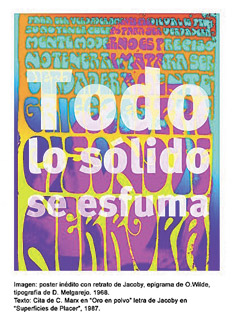 operated as part of the installation 1968: the ass you buckle, in the gallery Appetite, 2008.
operated as part of the installation 1968: the ass you buckle, in the gallery Appetite, 2008. 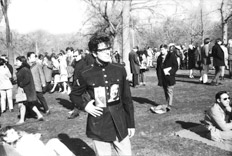 Mao and Peron, one heart, at Central Park in New York, 1967.
Mao and Peron, one heart, at Central Park in New York, 1967. 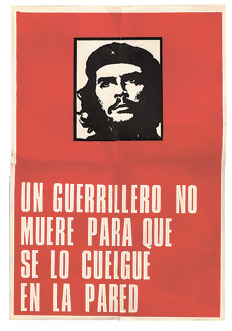 Anti-poster of Che Guevara with the phrase "A guerrilla is killed in order to hang it on the wall." 1969. Jacoby
Anti-poster of Che Guevara with the phrase "A guerrilla is killed in order to hang it on the wall." 1969. Jacoby 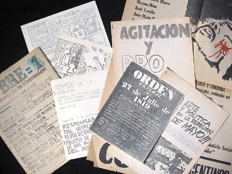 with Umberto Eco that impacted 1969.
with Umberto Eco that impacted 1969. 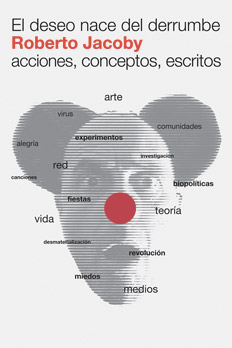 catalog shows that opened on 25 February at the Museo Nacional Centro de Arte Reina Sofia (Madrid) and will run until May 30 this year, will present the book "The desire is born of the landslide. Roberto Jacoby, writings, actions, concepts (Buenos Aires / Barcelona, \u200b\u200b2011), which holds its first projects, statements, songs, conversations and other texts by the artist and sociologist. The book is the result of years of research of the conceptual network of the South and is published under the imprint of Editions La Central, Adriana Hidalgo Editora National Museum Reina Sofia Art Center, edited by Ana Longoni care.
catalog shows that opened on 25 February at the Museo Nacional Centro de Arte Reina Sofia (Madrid) and will run until May 30 this year, will present the book "The desire is born of the landslide. Roberto Jacoby, writings, actions, concepts (Buenos Aires / Barcelona, \u200b\u200b2011), which holds its first projects, statements, songs, conversations and other texts by the artist and sociologist. The book is the result of years of research of the conceptual network of the South and is published under the imprint of Editions La Central, Adriana Hidalgo Editora National Museum Reina Sofia Art Center, edited by Ana Longoni care. 






